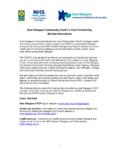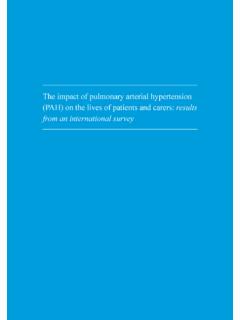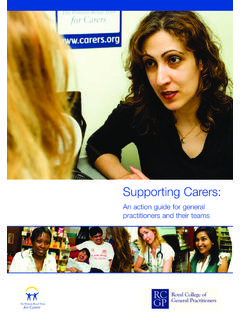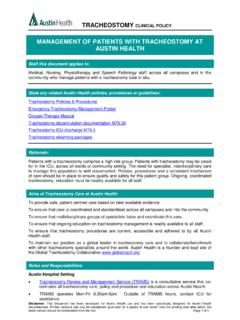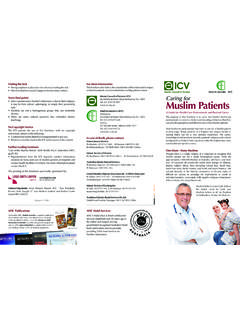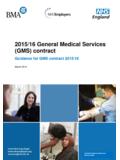Transcription of RESEARCH REPORT 416 - HSE: Information about health and ...
1 HSEH ealth & SafetyExecutiveInformation to accompany patients undergoing nuclear medicine procedures Prepared by the Royal Surrey County Hospital and the University of Surrey for the health and Safety Executive 2006 RESEARCH REPORT 416 HSEH ealth & SafetyExecutiveInformation to accompany patients undergoing nuclear medicine procedures Claire Greaves1, Victoria Senior2, Julie Barnett2, Marie Clark2, Joanna Pope2 and Paul Hinton1 Royal Surrey County Hospital 1 Medical Physics Department Royal Surrey County Hospital Guildford Surrey GU2 7XX University of Surrey 2 Department of Psychology University of Surrey Guildford Surrey GU2 7XH The aim of this RESEARCH was to investigate Information on restricting the exposure to radiation from nuclear medicine patients following diagnostic and therapeutic procedures. It comprised an audit of current practice in UK departments and interviews and focus groups exploring the views and experiences of patients and professionals.
2 The majority of departments provide verbal and/or written Information on restricting contact with others, particularly pregnant women and children. Fewer departments give instructions about minimising contamination. On the whole, Information provided complies with or, in the case if diagnostic procedures, goes beyond the restrictions specified in the Medical and Dental Guidance Notes. Information is rarely produced in formats for people with disabilities or people who do not have English as a first language. We identified a need to communicate more effectively with patients the rationale for restrictions and the consequences of non-adherence. We also identified a need to raise awareness of radiation protection issues and disseminate Information more effectively with professionals outside of nuclear medicine departments.
3 Ways in which both of these needs can be addressed are discussed. This REPORT and the work it describes were funded by the health and Safety Executive and the Department of health . Its contents, including any opinions and/or conclusions expressed, are those of the author(s) alone and do not necessarily reflect HSE or DoH policy. HSE BOOKS Crown copyright 2006 First published 2006 All rights reserved. No part of this publication may be reproduced, stored in a retrieval system, or transmitted in any form or by any means (electronic, mechanical, photocopying, recording or otherwise) without the prior written permission of the copyright owner. Applications for reproduction should be made in writing to: Licensing Division, Her Majesty's Stationery Office, St Clements House, 2-16 Colegate, Norwich NR3 1BQ or by e-mail to ii ACKNOWLEDGEMENTS We would like to thank the staff in the Medical Physics Department at the Royal Surrey County Hospital and members of the Institute of Physics in medicine (IPEM) nuclear medicine Special Interest Group (NMSIG) for their help in piloting the questionnaire.
4 We would also like to thank staff in the Medical Physics and nuclear medicine Departments at the Royal Surrey County Hospital for their help with recruitment of patients and the patients who agreed to take part in the study. Finally, we would like to thank all the participants in the focus groups and the workshops. Their comments were extremely valuable. iii iv CONTENTS Acknowledgements .. iii v EXECUTIVE 1 Aims of the RESEARCH .. 1 Components of the 1 Main findings .. 1 1. MAIN 3 Introduction .. 3 Current Advice .. 4 Communication And Restrictions .. 5 Aims And Objectives .. 6 Format Of The REPORT .. 7 Methods .. 8 Results .. 9 Overall Conclusions .. 14 References .. 15 2. ANNEX 1: NATIONAL SURVEY OF RADIATION PROTECTION Information PROVIDED IN ORDER TO MINIMISE THE HAZARD FROM nuclear medicine 17 Introduction .. 17 Aims And Objectives .. 18 Definitions.
5 18 19 Results .. 20 Discussion .. 37 Conclusions .. 40 Practical Implications .. 41 References .. 42 3. ANNEX 2: EVALUATION OF DIAGNOSTIC AND THERAPEUTIC PATIENT Information LEAFLETS .. 43 Summary .. 43 Overview .. 43 Aims And Objectives .. 43 44 Results .. 46 Discussion .. 55 Practical Implications .. 57 References .. 58 4. ANNEX 3: EXPERIENCES AND PERCEPTIONS OF patients UNDERGOING DIAGNOSTIC AND THERAPEUTIC nuclear medicine PROCEDURES .. 59 Summary .. 59 Aims And Objectives .. 59 60 Results .. 61 Practical Implications .. 70 References .. 71 v 5. ANNEX 4: UNDERSTANDING AND ACTING ON RADIATION PROTECTION Information : THE PERSPECTIVE OF health CARE PROFESSIONALS .. 73 Summary .. 73 Aims And Objectives: .. 74 74 75 Practical Implications .. 89 References .. 90 6. ANNEX 5: WORKSHOPS TO DISSEMINATE RESEARCH FINDINGS AND OBTAIN 91 Introduction.
6 91 Workshop 1 Professionals with expertise in nuclear medicine and Radiation Protection .. 91 Workshop 2 Patient representatives or experts in the provision of patient 94 Conclusions and further RESEARCH .. 96 References .. 97 APPENDIX 1 QUESTIONNAIRE .. 99 APPENDIX 2 PATIENT Information SHEET AND CONSENT 121 APPENDIX 3 STIMULUS MATERIALS .. 125 vi EXECUTIVE SUMMARY AIMS OF THE RESEARCH The overall aims of this RESEARCH were to - audit current practice in UK departments conducting diagnostic and therapeutic nuclear medicine procedures regarding the provision of Information to patients (to restrict radiation exposure to others) and professionals who come into contact with these patients investigate the experiences and views of patients and professionals regarding the content and implementation of such Information . Achieving these aims will enable the HSE to develop guidelines for the production and implementation of Information that effectively increases understanding of radiation hazards and successful restriction of exposure.
7 COMPONENTS OF THE RESEARCH The RESEARCH comprised two main components. The first component comprised an audit of current practice in UK departments conducting nuclear medicine procedures regarding the provision of Information for patients undergoing diagnostic and therapeutic procedures. A questionnaire survey of current practice was completed by UK departments conducting diagnostic (n=108) and therapeutic (n=57) nuclear medicine procedures. In addition, these departments were asked to supply copies of written Information disseminated to patients and professionals. A total of 92 departments supplied us with some form of written Information which primarily comprised of written Information disseminated to patients . An evaluation of the quality and content (contact and contamination restrictions and explanation of the rationale for restrictions) was conducted on written Information for patients undergoing diagnostic (bone, heart, lung, and parathyroid scans) and therapeutic (radioiodine therapy for thyrotoxicosis) procedures.
8 The second component comprised of qualitative studies of the views and experiences of patients and professionals who come into contact with patients following nuclear medicine procedures. Semi-structured interviews with 24 patients undergoing diagnostic and therapeutic procedures were conducted and analysed. Five focus groups with different relevant groups of professionals (including nuclear medicine staff, other hospital staff, staff working in the community ( practice nurses, nursing home staff, carers and a general practitioner), and professionals who may handle a radioactive corpse) were conducted and analysed. MAIN FINDINGS The 109 departments who responded to the questionnaire survey conducted a wide range of different diagnostic and therapeutic nuclear medicine procedures. Most departments relied on verbal and written Information leaflets and very few provided Information in alternative formats, such as for patients with disabilities.
9 The majority of departments only supplied written Information in English and depended on other means of communicating with non-English speaking patients (such as interpreters and family members). Both patients and professionals supported more Information on sources of reputable Information such as websites. The majority of departments across both diagnostic (94%) and therapeutic (98%) procedures give patients verbal and/or written Information on restricting contact with others. Fewer departments (57%) performing diagnostic procedures provide Information to patients with the aim of minimising contamination, whereas the majority of departments (93%) performing therapeutic procedures 1 do provide this Information . The evaluation of written Information suggests that there is large variation in specific advice for minimising contamination (for similar procedures) and greater consensus on appropriate advice seems warranted.
10 On the whole it appears that many departments are providing advice about restrictions that is in line with or goes beyond guidance in the Medical and Dental Guidance Notes (MDGN). The departments conducting diagnostic procedures primarily presented advice about restricting contact with pregnant women and children, typically for up to 24 hours following the procedure. However, only 72% reported restricting breast-feeding. For departments conducting therapeutic procedures, there was quite large variation in the restriction period specified although mean times were typically equivalent to the MDGN. Some written Information presents very specific advice about contact restrictions ( , distance and time per day) and this format was preferred by patients who were interviewed. Explanations in written Information of the rationale for restrictions ( , risk to self and others) were rather minimal and appeared to be presented with the aim of downplaying risks and, as a result, reassuring patients (an interpretation that was supported in discussions in the focus groups).










